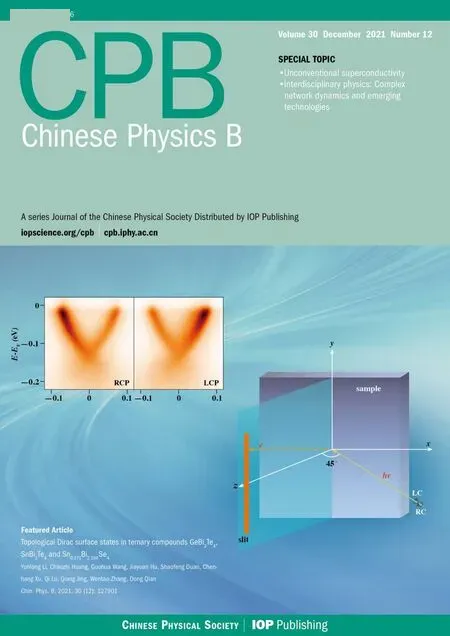Tunable wide-angle multi-band mid-infrared linear-to-linear polarization converter based on a graphene metasurface∗
2021-12-22LanLanZhang张兰兰PingLi李萍andXiaoWeiSong宋霄薇
Lan-Lan Zhang(张兰兰), Ping Li(李萍), and Xiao-Wei Song(宋霄薇)
School of Medical Technology and Engineering,Henan University of Science and Technology,Luoyang 471000,China
Keywords: metasurface,graphene,polarization converter,multi-band
1. Introduction
Effectively manipulating the state of optical polarization is highly valuable.[1–3]Conventional polarization control methods usually include using optical grating, dichroic crystal,Faraday effects,and birefringent materials,etc.[4–6]These approaches require a long optical distance to accumulate the phase difference, which means that the traditional polarization devices are usually bulky and are not suitable for applications requiring miniaturization of optical elements. Therefore,it is urgent to develop new miniaturized polarization devices to meet many practical applications.
In recent years, metamaterials or metasurfaces have attracted increasing attention.[7,8]Researchers have found that they can easily modulate the polarization modes of electromagnetic (EM) waves.[9–13]To date, a series of novel polarization converters have been realized and studied by using metasurface,[14–20]which greatly promote the development of optoelectronics and optical communication.However,once these polarization converters are manufactured, most of them can neither be externally tuned nor electrically switched,which limits their development.
Graphene,a novel two-dimensional material,has aroused great interest of researchers in recent years. Graphene has high conductivity and can be continuously tuned by external electrostatic biasing,[21]which provides a bright perspective for the design of tunable optical devices.[22–26]Among these tunable devices, polarization converter is an indispensable component. Recently,many polarization converters have been reported by using graphene.[27–33]For example, Penget al.reported a reflection-type polarization converter using graphene, which is composed of a strip-loaded half elliptical graphene ring array. The polarization converter not only convert linearly polarized incident wave into its crosspolarizations, but also convert circular polarization incident wave into its cross-polarizations.[34]Chenet al.proposed a tunable linear-to-linear(LTL)polarization converter by using hollowed “H” graphene patch array, which realized a broadband polarization conversion from 34.39 THz to 36.92 THz,and the polarization conversion ratio is more than 90%.[35]Penget al.presented a tunable double-band LTL polarization converter in the THz region by using coupled graphene nanostructure. The polarization conversion phenomenon is achieved due to the hybridization effect caused by coupling interactions between plasmonic resonances in two graphene discs.[36]Zhuet al.proposed a broadband sinusoidally-slotted graphene-based cross-polarization converter structure, which realized a tunable broadband polarization conversion from 1.28 THz to 2.13 THz, and the polarization conversion ratio is more than 85%.[37]Zenget al.proposed a dual-band crosspolarization converter by using U-shaped graphene nanostructures array.[38]Yaoet al.proposed a triple-band LTL polarization converter based on graphene metasurface with double L-shaped unit. The polarization conversion ratios are 96.9%, 96.2%, and 83% at 36.15, 48.95, and 52.20 THz,respectively.[39]A triple-band cross-polarization conversion function was also realized by introducing slits into the elliptical graphene array. The polarization conversion ratio is more than 95% at the three operating frequencies.[40]The above multi-band polarization converters are mostly double-band or triple-band. In practical applications, a four-band reflective LTL polarization converter is also needed. Recently, Chenet al.present a four-band reflective LTL polarization converter using two-layer graphene metasurface structure.[41]In their proposed polarization converter structure,two graphene metasurfaces are separated by the dielectric. Compared with the structure based on single-layer graphene, their fabrication is more difficult. To the best knowledge of the authors, fourband polarization converters based on single layer graphene metasurface have been rarely reported.
In this paper, a tunable wide-angle multi-band reflective LTL polarization converter using single-layer graphene metasurface is proposed and studied. It is a sandwich structure consisting of a single-layer graphene metasurface,a dielectric spacer,and a metal substrate. The single-layer graphene metasurface is composed of an array of two L-shaped graphene patches with different sizes. The polarization converter can transformsx-polarized wave intoy-polarized wave at four resonance frequencies. A High-efficiency, three-band, LTL polarization conversion can also be realized by carefully selecting the geometric parameters. Furthermore, the polarization converter also presents good angular stability under oblique incidence angles, and the working frequency of the proposed polarization converter can be flexibly tuned by changing the Fermi energy without refabricating the structures. Our fourband polarization converter with simpler structure is easily fabricated, which has great application potential in electromagnetic polarization control.
2. Theoretical model and design
A generalized schematic of the proposed reflection wideangle multi-band polarization converter is shown in Fig.1(a).The structure consists of a graphene array at the top, a silica(ε=2.25)dielectric spacer with thicknessts=1000 nm in the middle,and a metal gold substrate with thicknesstm=150 nm at the bottom. Figure 1(b) shows one unit of the proposed structure. Here,graphene layer is composed of two L-shaped graphene sheets with different lengths and widths.drepresents the distance between two L-shaped graphene,L1andW1represent the length and width of the larger L-shaped graphene patch,L2andW2represent the length and width of the smaller L-shaped graphene patch,PxandPyrepresents the periods in thexandydirections. The unit-cell has the following geometric parameters:L1=114 nm,W1=62 nm,L2=74 nm,W2=37 nm,d=6 nm,Px=Py=160 nm. The manufacturing processes of our proposed structure is feasible. In potential fabrication,the substrate gold layer can be obtained by electron beam evaporation, and the silica dielectric acts as an adhesive layer. A large-area graphene film can be fabricated by an optimized liquid precursor chemical vapor deposition method[42]and can be transferred onto silica layer. Two Lshaped array can be obtained by oxygen plasma etching and electron beam lithography.[43]

Fig.1. (a)Schematic diagram of the proposed wide-angle multi-band polarization converter, where tm =150 nm,ts =1000 nm. (b)Unit cell of structure,where L1=114 nm,W1=62 nm,L2=74 nm,W2=37 nm,d=6 nm,Px=Py=160 nm.
The permittivity of metal gold substrate is described by the Drude model.[44]The graphene’s relative permittivityεGcan be obtained by[45]

where, the impedance of airηis about 377 Ω,∆=1 nm is the typical thickness of graphene thickness,δGrepresents the surface conductivity of graphene. In the mid-infrared range,δGcan be calculated approximately as

where, ¯h,kB, anderepresent the reduced Plank’s constant,Boltzmann’s constant,and electron charge,respectively.ω,T(=300 K),τandEfare the angular frequency of the incident light, room temperature, electron scattering time, and Fermi energy level,respectively.
In our simulations,all the electromagnetic simulation results are obtained via the COMSOL software,which are based on the finite element method(FEM).A plane wave with anxpolarized electric field is used as the excitation source. The property of our proposed polarization converter can be described with a reflection matrix,which is as follows:[46]

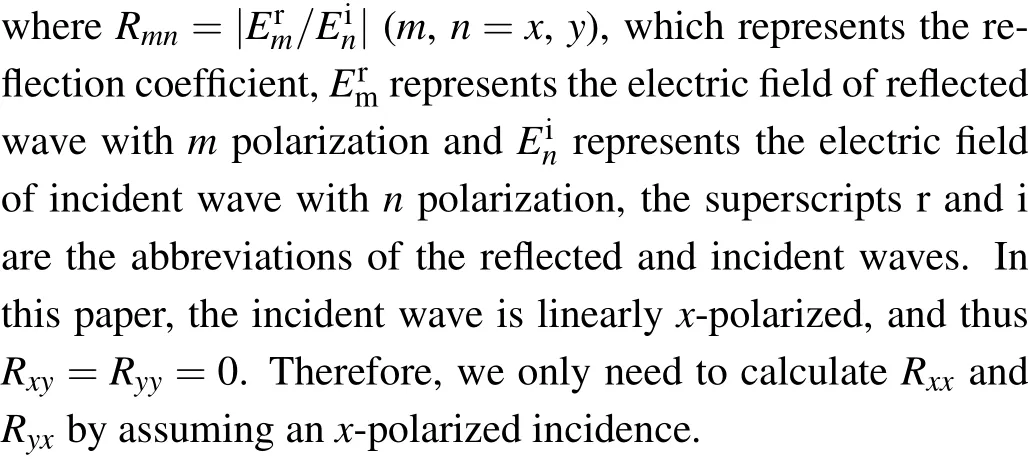
To measure the polarization conversion performance,the polarization conversion ratio(PCR)is defined as[47,48]

3. Results and discussion
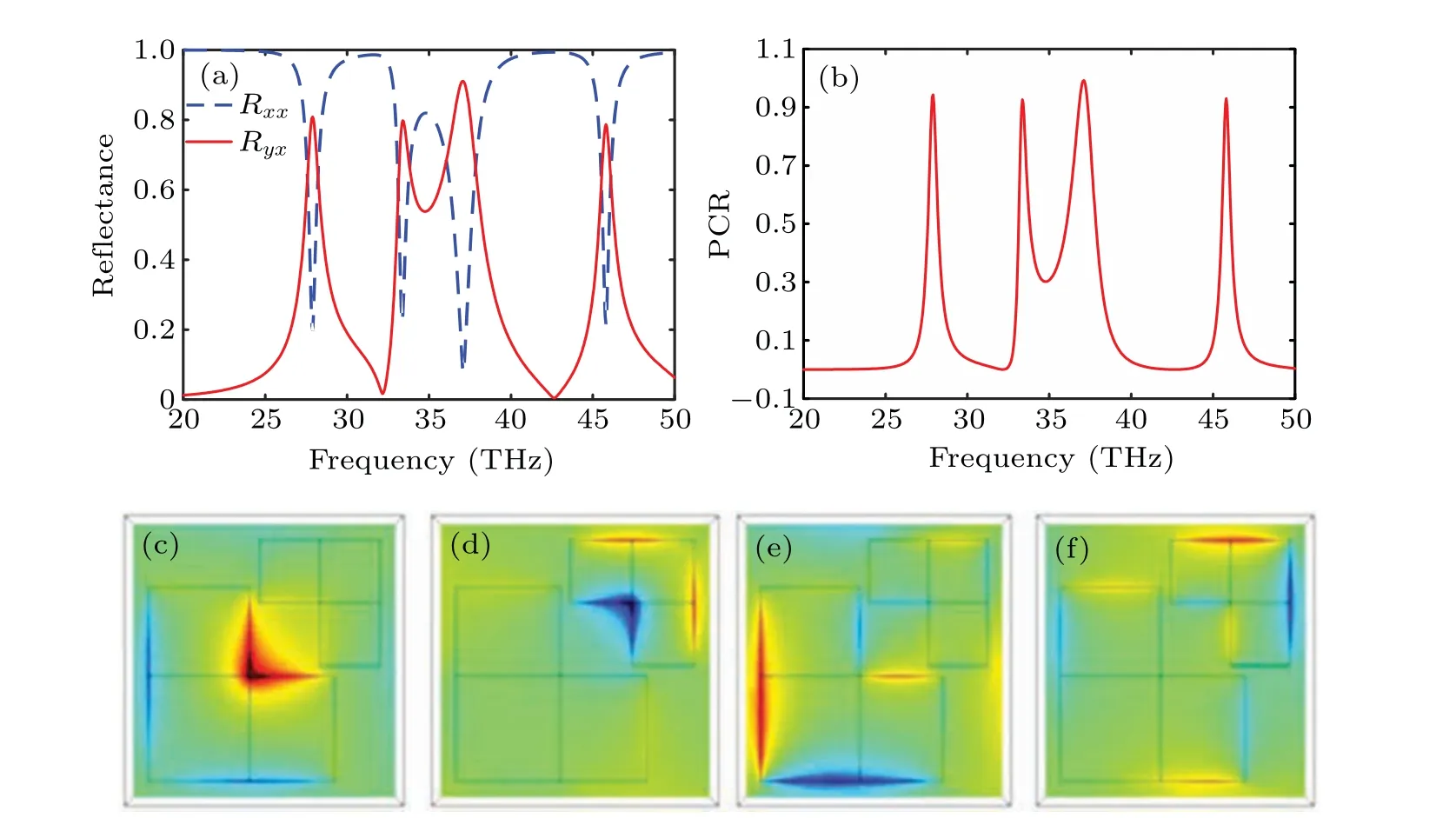
Fig. 2. Numerical results of the proposed wide-angle multi-band polarization polarization converter for normal incident. (a) Calculated copolarization reflection(Rxx)and cross-polarization reflection(Ryx). (b)Calculated PCR spectrum;the magnetic field profiles Hz on the surface of the graphene patch for 27.90 THz(c),33.35 THz(d),37.10 THz(e),and 45.80 THz(f),respectively.
The co-polarization reflection (Rxx=|rxx|2) and crosspolarization reflection (Ryx=|ryx|2) for normal incident are shown in Fig. 2(a), whereEf=1 eV,τ=1 ps. It is clearly seen that there are four high reflection peaks inRyxat 27.90,33.35, 37.10, and 45.80 THz, respectively. On the contrary,four low reflection dips appear inRxxat these four same frequencies. The PCR spectrum is shown in Fig.2(b). The PCR spectrum shows four peaks which reach 94.4%,92.7%,99.3%,and 93.1%at 27.90,33.35,37.10,and 45.8 THz,respectively.These phenomena indicate that the designed structure can realize the four-band of polarization transfer fromxtoydirection. Figures 2(c)–2(f)depict the magnetic field profilesHzon the surface of the graphene patch for 27.90,33.35,37.10,and 45.80 THz, respectively. The magnetic field distributionsHzare located on the edges of the graphene patch.
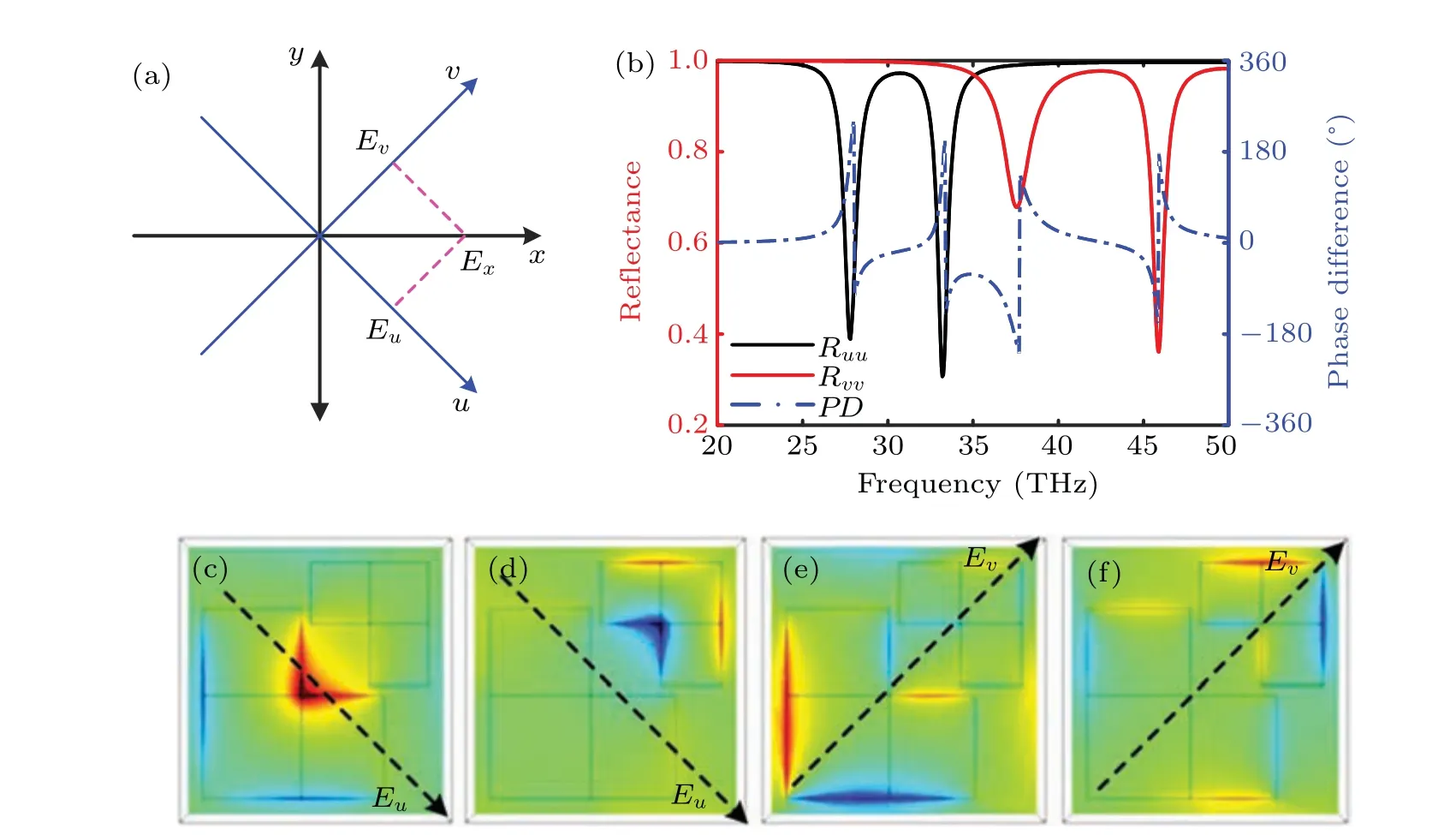
Fig.3. (a)Schematic diagram of the decomposition of linearly polarized incident wave,(b)simulated co-polarization reflection(Ruu,Rvv)for polarization converter at incidences with −45◦(Eu) and 45◦(Ev) polarizations. Panels (c)–(f) show the z component of the magnetic field distribution(Hz)at different frequencies(c)27.90 THz with Eu incidence,(d)33.50 THz with Eu incidence,(e)37.10 THz with Ev incidence,and(f)45.80 THz with Ev incidence,respectively.
To further reveal the physical mechanism of our proposed graphene-based polarization conversion, we analyzed the other two incident cases:EuandEv. For anx-polarized incident wave,it can be decomposed into two orthogonal polarized components with equal magnitudes and phases,here theuaxis and thevaxis are the directions that along 45◦and−45◦clockwise from the +x-axis direction, as shown in Fig. 3(a).Figure 3(b) shows two simulated reflection coefficientsRuuandRvvunderEuandEvincidences, respectively. There are two dips inRuuat 27.90 THz,33.35 THz and two dips inRvvat 37.10 THz,45.80 THz. These four dips originate from four eigenmodes, which are excited byEuandEv. The first two modes are excited byEupolarization incidence at 27.90 THz and 33.35 THz,and the latter two modes are excited byEvpolarization incidence at 37.10 THz and 45.80 THz. These four modes are all derived from the excitation of the graphene surface plasmons(GSPs). The calculated PD ∆ϕ=ϕvvϕuuis also shown in Fig. 3(b). ∆ϕis close to 180◦, 180◦,−180◦, and 0◦at 27.90, 33.35, 37.10, and 45.8 THz. Therefore, at these four resonant frequencies, the superimposition of the two reflected components can produce the polarization rotation with rotation angle of 90◦. The magnetic field profilesHzat frequencies of 27.90 THz and 33.35 THz forEuincidence are shown in Figs.3(c)and 3(d),and these two eigenmodes show symmetric magnetic field distribution about the 45◦direction.The magnetic field profilesHzat frequencies of 37.10 THz and 45.80 THz forEvincidence are shown in Figs. 3(e) and 3(f), and these two eigenmodes show anti-symmetrical magnetic field distribution about the 45◦direction.
Figure 4 shows the simulated PCR under different incident angles,and the other parameters are the same with those of Fig. 2. The PCR is quite stable for the change of incident angle. When the incident angles increase from 0◦to 60◦four working frequencies of proposed polarization converter at 27.90,33.35,37.10,and 45.80 THz are almost unchanged,and the PCR peak values at these four resonant frequencies are also keep the same.Our polarization converter is based on four localized GSPs resonances,which are insensitive about the incident angle. The small feature size of graphene also contributes to the angle insensitivity of our device. In generally,at the same resonant frequency, the feature size of graphene plasmonic structure is several times smaller than the metal counterpart, which leads to less dependence on the incident angle.[30]When the incident angle is more than 60◦the third PCR peak positions have obvious shift, and the PCR peak values of some resonant frequencies decrease. The reason is that the interaction between the electromagnetic wave and graphene is weakened under the large incident angle.[35]The simulation results imply that the proposed polarization converter is angle-insensitive.
To better understand the excitation of these plasmonic resonant modes, the geometric parametersL1andL2are changed for further study. The corresponding PCRs are illustrated in Figs.5(a)–5(b),respectively. In Fig.5(a),with the increase ofL1(from 112 nm to 118 nm),we notice that the first and third PCR peak positions have obvious red-shifted,but the other two peak positions are almost unchanged, In Fig. 5(b),we notice that the second and fourth PCR peak positions have obvious red-shifted with the increase ofL2,while the position of other two peaks do not change significantly. WhenL2is reduced(from 74 nm to 68 nm),the third PCR peak and second PCR peak are close to each other. Finally,whenL2=68 nm,the second and third polarization conversion bands are coupled to each other,resulting in a wide polarization conversion band in which PCR is greater than 99.2% in the frequency range from 36.45 THz to 37.6 THz. Thus,a three-band polarization converter is achieved, and the three polarization conversion ratios reach 91.50%, 99.20%, and 97.22%, respectively. The above red-shift behavior shown in Figs.5(a)–5(b)can be expected from the magnetic field profiles in Figs.2(c)–2(f). It can be seen from Figs.2(c)and 2(e)that the magnetic field energy is mainly distributed at the edges of the large Lshaped graphene patch for the frequencies of 27.90 THz and 37.10 THz. While the magnetic field energy is mainly distributed at the edges of the small L-shaped graphene patch for the frequencies of 33.35 and 45.80 THz, seen in Figs. 2(d)and 2(f). Therefore, the adjustment of geometric parameters of large L-shaped graphene patch (L1) has a greater impact on the first and the third operating frequencies (27.90 THz and 37.10 THz)than the second and the fourth operating frequencies. But the second and the fourth operating frequencies(33.35 THz and 45.80 THz)are mainly dependent on geometric parameters of small L-shaped graphene patch(L2).
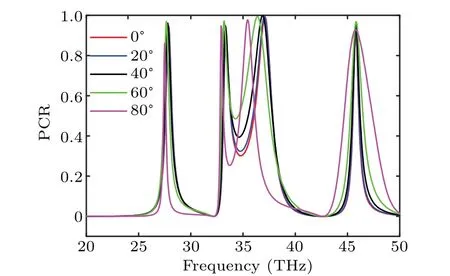
Fig.4.Simulation of PCRs under different incident angles.Other parameters are the same as those in Fig.2.
Next,the tunable properties of proposed four-band polarization conversion are discussed. It has been reported that the Femi energy of graphene can be tuned in the range of about−1 eV to 1eV by changing electrical gating,[49]which indicates that graphene has great potential in tunable devices. The PCRs for different graphene Fermi energy (Ef) are presented in Fig.6,other parameters are fixed as same as before. From Fig.6,we can see that the PCRs are tunable over a wide range of frequencies. WhenEfis decreased from 1 eV to 0.8 eV,four peaks of PCR are red-shifted from 27.90, 33.35, 37.10,and 45.80 THz to 25.00, 29.85, 33.25, and 40.90 THz, respectively. The reason of red-shift phenomenon is that the plasmonic resonant frequency(f)has a functional relationship with(Ef)1/2.[50]Therefore,the decrease ofEfcan result in the red-shift of the four peak positions.

Fig.5. Effects of geometric parameters on the performance of the proposed polarization converter. (a)Varying L1,(b)varying L2.
WhenL2=68 nm, the PCRs of triple-band polarization conversion for different graphene Fermi energies(Ef)are presented in Fig. 7. The working frequencies of three-band polarization conversion are all red-shift withEfdecreasing from 1 eV to 0.8 eV.This phenomenon is attributed to the red shift of the GSPs’resonant frequency(f)with decreasing the Fermi energy(Ef).
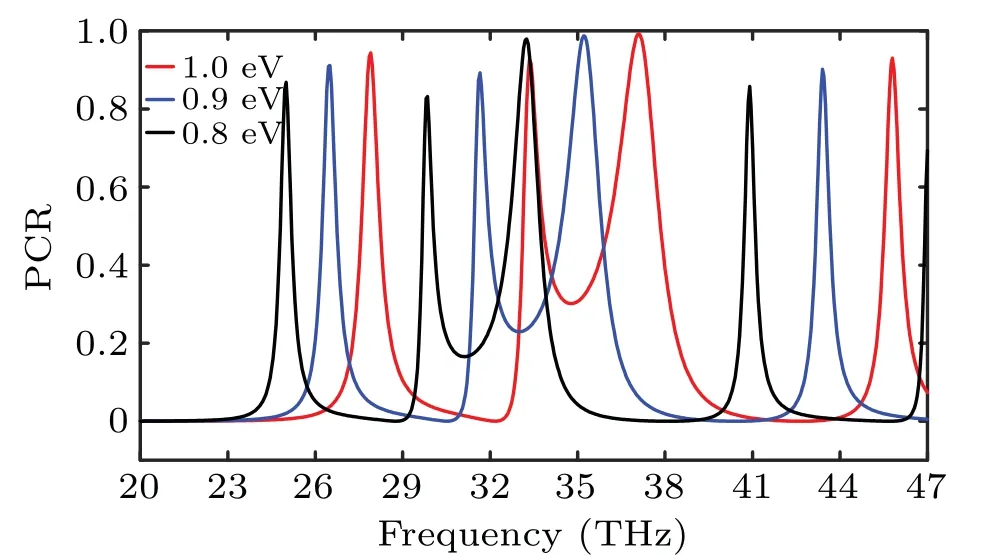
Fig.6. Simulated PCRs of four-band LTL polarization converter for different graphene Fermi energies(Ef).

Fig.7. Simulated PCRs of triple-band LTL polarization converter for different graphene Fermi energies(Ef).

Table 1. Comparisons of our proposed device with other graphene-based multi-band polarization converters.
We compared the key characteristics of our proposed device with other graphene based multi-band polarization converters reported in recent years. As shown in Table 1,the polarization converters based on single-layer graphene metasurface proposed in Refs.[28,29,32,36,39,40]are mostly doubleband or triple-band. Although a four-band polarization converter is proposed in Ref.[41]it is based on bilayer grapehen metasurface. Compared with bilayer graphene-based polarization converter proposed in Ref. [41] our proposed single layer graphene-based structure has the characteristics of simpler structure and easier fabrication.
4. Conclusion
In summary, we proposed to achieve dynamically tunable multiple-band LTL polarization conversion by using a graphene metasurface, which is composed of an array of two L-shaped graphene patches with different sizes. The calculation results indicated that the proposed converter can transformx-polarized light intoy-polarized light at four resonance frequencies simultaneously. The PCR can reach 94.4%, 92.7%,99.3%,and 93.1%at 27.90,33.35,37.10,and 45.8 THz.Also,the dynamically tunable triple-band LTL polarization conversion can be realized by designing reasonable geometric parameters. The PCR can reach 91.50%, 99.20%, and 97.22%.The simulation results also indicate that the working frequency of the polarization converter can be easily tuned by changing the Fermi energy instead of redesigning the structure.Furthermore, our polarization converter shows good angleindependent property. We believe that our design will have potential applications in electromagnetic polarization control.
猜你喜欢
杂志排行
Chinese Physics B的其它文章
- Modeling the dynamics of firms’technological impact∗
- Sensitivity to external optical feedback of circular-side hexagonal resonator microcavity laser∗
- Controlling chaos and supressing chimeras in a fractional-order discrete phase-locked loop using impulse control∗
- Proton loss of inner radiation belt during geomagnetic storm of 2018 based on CSES satellite observation∗
- Embedding any desired number of coexisting attractors in memristive system∗
- Thermal and mechanical properties and micro-mechanism of SiO2/epoxy nanodielectrics∗
